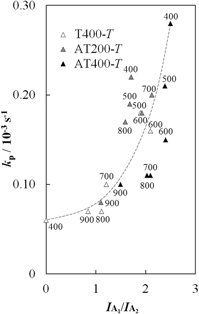Crossref Citations
This article has been cited by the following publications. This list is generated based on data provided by
Crossref.
Li, Yuxin
Fu, Rong
Wang, Xiangdong
and
Guo, Xiaoling
2018.
Preparation of core–shell nanostructured black nano-TiO2 by sol–gel method combined with Mg reduction.
Journal of Materials Research,
Vol. 33,
Issue. 24,
p.
4173.
Matsunami, Daichi
Yamanaka, Keisuke
Mizoguchi, Tadashi
and
Kojima, Kazuo
2019.
Comparison of photodegradation of methylene blue using various TiO2 films and WO3 powders under ultraviolet and visible-light irradiation.
Journal of Photochemistry and Photobiology A: Chemistry,
Vol. 369,
Issue. ,
p.
106.
Ren, Chaojun
Li, Wenjun
Li, Hongda
Liu, Xintong
Liu, Yichen
Li, Xinyang
Lin, Chenxiang
and
Zhou, Hualei
2019.
Ultrasmall Pt nanoclusters deposited on europium oxide: A newly active photocatalyst for visible-light-driven photocatalytic hydrogen evolution.
Applied Surface Science,
Vol. 480,
Issue. ,
p.
96.
Zammouri, Lobna
Aboulaich, Abdelhay
Capoen, Bruno
Bouazaoui, Mohamed
Sarakha, Mohamed
Stitou, Mostafa
and
Mahiou, Rachid
2019.
Synthesis of YAG:Ce/ZnO core/shell nanoparticles with enhanced UV-visible and visible light photocatalytic activity and application for the antibiotic removal from aqueous media.
Journal of Materials Research,
Vol. 34,
Issue. 08,
p.
1318.
Wu, Shizi
Xie, Yao
Zhang, Xianmei
Huang, Zhaohui
Liu, Yangai
Fang, Minghao
Wu, Xiaowen
and
Min, Xin
2019.
In situ synthesis of adsorptive β-Bi2O3/BiOBr photocatalyst with enhanced degradation efficiency.
Journal of Materials Research,
Vol. 34,
Issue. 20,
p.
3450.
Ding, Xiaodong
Wang, Wei
Zhang, Ao
Zhang, Lishan
and
Yu, Dan
2019.
Efficient visible light degradation of dyes in wastewater by nickel–phosphorus plating–titanium dioxide complex electroless plating fabric.
Journal of Materials Research,
Vol. 34,
Issue. 6,
p.
999.
Dai, Xiaojuan
Jiao, Zeqing
Ma, Zehan
Liu, Kunhui
Wang, Chen
and
Su, Hongmei
2019.
Capturing the Long-Lived Photogenerated Electrons in Au/TiO2 upon UV or Visible Irradiation by Time-Resolved Infrared Spectroscopy.
The Journal of Physical Chemistry C,
Vol. 123,
Issue. 33,
p.
20325.
Hao, Yaru
Deng, Zhaoqi
Zhao, Ziquan
and
Song, Xijia
2020.
A facile synthesis of a highly efficient β-Bi2O3/Bi2O2CO3 heterojunction with enhanced photocatalytic NO oxidation under visible light.
New Journal of Chemistry,
Vol. 44,
Issue. 26,
p.
10989.
Wang, Lele
Chen, Shanshan
Wu, Pengcheng
Wu, Keliang
Wu, Jianning
Meng, Guihua
Hou, Juan
Liu, Zhiyong
and
Guo, Xuhong
2020.
Enhanced optical absorption and pollutant adsorption for photocatalytic performance of three-dimensional porous cellulose aerogel with BiVO4 and PANI.
Journal of Materials Research,
Vol. 35,
Issue. 10,
p.
1316.
Menon, Nambath Gayathri
Tatiparti, Sankara Sarma V.
and
Mukherji, Suparna
2020.
Selective Removal of Photocatalytically Active Anatase TiO2 Phase from Mixed‐Phase TiO2‐ZnO Nanocomposites: Impact on Physicochemical Properties and Photocatalytic Activity.
ENERGY & ENVIRONMENTAL MATERIALS,
Vol. 3,
Issue. 4,
p.
548.
Jawale, Vivekanand
Gugale, Gulab
Chaskar, Manohar
Pandit, Shivaji
Pawar, Ramdas
Suryawanshi, Shivani
Pandit, Vikram
Umarji, Govind
and
Arbuj, Sudhir
2021.
Two- and three-dimensional zinc oxide nanostructures and its photocatalytic dye degradation performance study.
Journal of Materials Research,
Vol. 36,
Issue. 7,
p.
1573.
Ganharul, Grace Kelly Q.
Tofanello, Aryane
Bonadio, Ariany
Freitas, André L. M.
Escote, Márcia T.
Polo, André S.
Nantes-Cardoso, Iseli L.
and
Souza, José Antonio
2021.
Disclosing the hidden presence of Ti3+ ions in different TiO2 crystal structures synthesized at low temperature and photocatalytic evaluation by methylene blue photobleaching.
Journal of Materials Research,
Vol. 36,
Issue. 16,
p.
3353.
Zong, Zhifang
Chen, Depeng
Zhao, Chunxiao
Tang, Gang
Ji, Yilong
Zhang, Hao
and
Lv, Zhong
2021.
Application of Ce–Eu/TiO2 phase change material as the wall material to improve the indoor environment.
Journal of Materials Research,
Vol. 36,
Issue. 3,
p.
615.
Huang, Zheao
Zhou, Jianqing
Zhao, Yingying
Cheng, Hengbin
Lu, Gongxuan
Morawski, A. W.
and
Yu, Ying
2021.
Stable core–shell ZIF-8@ZIF-67 MOFs photocatalyst for highly efficient degradation of organic pollutant and hydrogen evolution.
Journal of Materials Research,
Vol. 36,
Issue. 3,
p.
602.
Giordani, Thainá
Dose, Janaine
Kuskoski, Yassmin
Schultz, Juliana
Mangrich, Antonio Salvio
de Mello, Josiane Maria Muneron
Silva, Luciano Luiz
Zeferino, Rubieli Carla Frezza
Zanetti, Micheli
Fiori, Márcio Antônio
and
Colpani, Gustavo Lopes
2021.
Photocatalytic degradation of propranolol hydrochloride using Nd–TiO2 nanoparticles under UV and visible light.
Journal of Materials Research,
Vol. 36,
Issue. 7,
p.
1584.
Ganharul, Grace Kelly Q.
Tofanello, Aryane
Bonadio, Ariany
Freitas, André L. M.
Escote, Márcia T.
Polo, André S.
Nantes-Cardoso, Iseli L.
and
Souza, José Antonio
2022.
Outstanding cooperation of all-inorganic CsPbI3 perovskite with TiO2 forming composites and heterostructures for photodegradation.
Journal of Materials Science,
Vol. 57,
Issue. 36,
p.
17363.
Varangane, Sagar
Vennapoosa, Chandra Shobha
Tiwari, Amritanjali
Nataraj, Sanna Kotrappanavar
Yendrapati, Taraka Prabhu
and
Pal, Ujjwal
2022.
In situ synthesis of Cu‐doped ZIF‐8 for efficient photocatalytic water splitting.
Applied Organometallic Chemistry,
Vol. 36,
Issue. 9,
Daskalova, Desislava
Aguila Flores, Gonzalo
Plachetka, Ulrich
Möller, Michael
Wolters, Julia
Wintgens, Thomas
and
Lemme, Max C.
2023.
Combined Structural and Plasmonic Enhancement of Nanometer-Thin Film Photocatalysis for Solar-Driven Wastewater Treatment.
ACS Applied Nano Materials,
Vol. 6,
Issue. 16,
p.
15204.
Khitous, Amine
Vidal, Loic
and
Soppera, Olivier
2024.
Optical and photocatalytic properties of sol-gel AuNPs@TiO2 ultrathin film.
Applied Surface Science,
Vol. 669,
Issue. ,
p.
160419.
Khitous, Amine
Noel, Laurent
Molinaro, Céline
Vidal, Loïc
Grée, Simon
and
Soppera, Olivier
2024.
Sol–Gel TiO2 Thin Film on Au Nanoparticles for Heterogeneous Plasmonic Photocatalysis.
ACS Applied Materials & Interfaces,
Vol. 16,
Issue. 8,
p.
10856.



